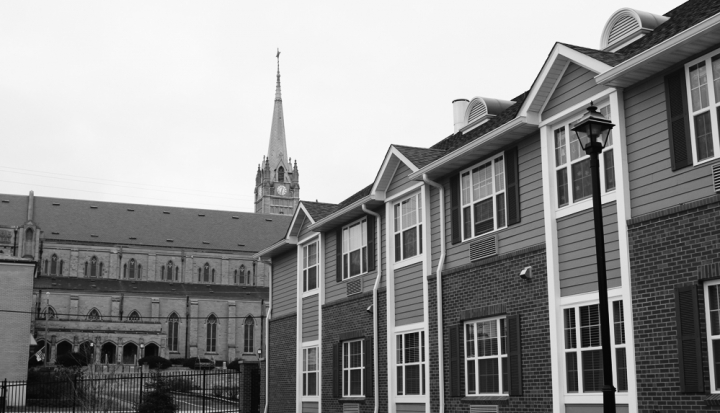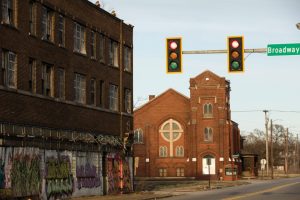Sixty-nine-year-old John Eckford is always ready to welcome a guest to his one-bedroom apartment. On the table next to his front door are displayed two small bottles of London dry gin and strawberry daiquiri mix. Eckford describes his home as “a bachelor pad.” It features two white leather couches, a flat screen television, and matching red cookware.
Eckford is one of the 41 seniors who lives at the Cottages at Cathedral Square, a housing development for low-income seniors in Belleville, Illinois. Today the buildings in the shadow of the Cathedral of St. Peter are an attractive and vibrant bridge to the bustling downtown. But 10 years ago this neighborhood looked very different.
In 2006 the corner of South First and West Harrison Streets featured an abandoned, decrepit pants factory—a sobering and unsightly relic of America’s 20th-century manufacturing capacity. Many of the factory’s windows were shuttered. Others were shattered. Its bricks were crumbling. Once home to the Charles Meyers Pants Company, in 2006 it instead housed so many pigeons that when cleaning crews entered they had to use hazmat suits.
Adjacent to the factory were a few dilapidated houses and the closed-down Corner Pocket Tavern. Also within this tired city block was a convent and activity center affiliated with the cathedral.
The block “was a place of crime and death,” says Monsignor John Myler, rector of the cathedral. “It’s now a place of peace.”
That’s due in large part to the monsignor’s own foresight, determination, and hard work. The decaying factory, run-down homes, and tavern have all been torn down and replaced with the Cottages at Cathedral Square, a 32-unit affordable housing development for low-income senior citizens.
“Our Holy Father calls us to the peripheries,” Myler says. That doesn’t necessarily mean a parish should look to another country or even outside its own geographical boundaries. Sometimes it means taking chances as a community to do something that has never been done before. “The periphery here was the very next block,” he says.
A factory, a tavern, and a vision
About six years ago the vacant pants factory was left to the Cathedral of St. Peter. Soon after, the parish received a letter from the city of Belleville telling them that they had to demolish the building.
The pastoral council initially hoped to simply demolish the factory as the city instructed, but they discovered from initial estimates that demolition would cost several hundred thousand dollars, perhaps half a million.
“The cathedral pastoral council met and said, ‘We’ll do what we have to do to be good neighbors, to eliminate any kind of urban blight, but let’s think outside the box a little bit,’ ” Myler recalls. “And that’s when we discovered that there was a need and possibility for affordable senior housing.”
Parishes like the Cathedral of St. Peter often devote much of their time, effort, and funding to young people through youth ministry and education, Myler says. But in this case, the cathedral realized that parishioners and Belleville residents were living longer and healthier lives and that there was a growing need for seniors to get out of high-maintenance homes and into a more practical living situation.
He says the parish saw an opportunity to address people in the community who had “moved to a ministry that hadn’t had a lot of emphasis.”
Because the cathedral is such a central part of the Belleville community, the parish felt a neighborly responsibility to spearhead the senior housing development—a responsibility Myler says all churches must take seriously. “When the church can be an anchor in a neighborhood we have a responsibility to be good neighbors,” Myler explains.
The cathedral consulted St. Patrick’s Center, a St. Louis-based nonprofit with experience helping churches and businesses convert old buildings into usable neighborhood space. But the factory was so deteriorated the cathedral council concluded it would be imprudent to try to repurpose the building.
The council’s vision broadened. If the entire city block was available for development, the cathedral and its consultants determined, an affordable senior housing complex could be built within it. In order to set that complicated process into motion, the cathedral purchased the factory’s adjacent residences and the Corner Pocket Tavern.
Myler jokes that the Cathedral of St. Peter is probably one of the few—if not the only—Catholic parishes in the country to have owned a neighborhood tavern.
The tavern would not stand for long—nor would the pants factory, the abandoned homes, or the convent. In 2014 all of the buildings within the city block, with the exception of the cathedral activity center, were demolished to make room for the housing development the council envisioned.
While the cathedral parish financed and directed some of the project’s earliest stages, the cathedral council understood that in order to be successful the project would need an experienced real estate development and management team. Touchette Regional Hospital in Centerville, Illinois and the Metropolitan Housing Development Cooperation in Chicago—both nonprofit organizations—became the principle developers and now manage the Cottages at Cathedral Square.
The total cost of the cottages project was about $8.6 million, according to documents filed with the Illinois Housing Development Authority. About 70 percent of the financing came from the St. Louis Equity Fund, which brings together investors to help fund affordable housing projects. In return, the investors (typically banks and large corporations) receive federal tax credits allocated by the state of Illinois.
The additional 30 percent of the development costs were covered by mortgages taken out by the limited partnership and grants, including $175,000 dollars from the City of Belleville.
Life at the Cottages
The Cottages at Cathedral Square officially opened in fall 2015. Living here “is a blessing,” says Carrie Clay, originally from East St. Louis, Illinois. “We don’t got to worry about nothing. The sidewalks are always clear. The lawns are always mowed. It’s peaceful. What more could we ask for?”
The Cottages’ 16 one-bedroom and 16 two-bedroom units have become a refuge to many seniors who cannot afford traditional housing units and who are seeking a community with whom they can live and grow. Today, all the units are full and about 50 seniors are on the waitlist, according to Nina Fields, the on-site manager at the Cottages. In order to qualify for housing, applicants must be 62 or older and meet a low-income threshold, which varies based on each resident’s situation. Some pay just 30 percent of their monthly income for rent while others pay up to 50 or 60 percent.
Each unit has 8-foot ceilings and a kitchen, living room, and bathroom with grab bars for stability. The units are all electric with individually controlled heating and cooling, a refrigerator, dishwasher, garbage disposal, and ceiling fans in the living room and bedrooms.
The two-bedroom cottages also have their own washer and dryer, as well as an individual storage area on the front porch.
The 31,000 square foot Cottages’ complex was built with Pope Francis’ Laudato Si’ (On Care for Common Home), in mind. In the spirit of sustainability, some materials from the demolition were repurposed, and the buildings’ appliances are all energy efficient.
The exterior of the complex—designed by EWR Associates in Fairview Heights, Illinois—was modeled after Belleville’s German-style architecture.
The grounds of the apartments are well kept and, if anything breaks, the ever-popular maintenance professional, Danny Hill, is on site to assist the residents.
Deloris McCoy, 68, shares Clay’s enthusiasm. Moving into the Cottages was “the best thing that ever happened to me,” she says.
In her previous apartment in Belleville, she had noisy neighbors all around her. She didn’t sleep well. At the Cottages, she regards the peace and quiet, echoing Clay, as “a blessing.”
And while the Cottages are peaceful and well-maintained, the residents are also fairly autonomous. “It’s independent living, not assisted living,” says Dave Ritter, a regional property manager who oversees the development.
By Catholics, but not for Catholics
Myler remembers one afternoon during the construction process when he was walking down the block watching the Cottages take shape. A man drove up, rolled down his window and asked, “Are these those apartments being built for Catholics?”
“I said, ‘No sir. They are cottages being built by Catholics, but not being built for Catholics,’ ” Myler recalls.
While the vision for the Cottages came from the Cathedral of St. Peter, the housing development now operates independently from the parish and the Catholic Church. In technical terms, it is a secular residence community with Catholic pastoral ministry available and a Catholic influence in its founding and in its day-to-day service, Myler explains.
“The people who live there are our neighbors, our friends, many of them are our parishioners—though you don’t have to be Catholic [to live there],” he says.
Indeed, the residents come from a variety of backgrounds. The apartments, housing 29 women and 12 men, are “racially and religiously diverse,” Fields says.
One woman who greets that diversity is Sister Carol Markus, a retired School Sister of Notre Dame (SSND) who volunteers as an activity coordinator at the Cottages several days a week.
Sister Carol’s two biological sisters, Joan and Theresa, also belong to the SSND, and the three religious and biological sisters live together in Belleville. Sister Theresa was one of only three religious sisters (and the only SSND) living in the convent when the structure was slated for demolition in order to build the Cottages. Sister Theresa moved across town, where she was ultimately joined by Carol and Joan.
Sister Carol, now 78, is said to be the backbone of the Cottages community. She plans activities and provides spiritual ministry. “I’m glad I met Sister Carol,” says Fannie Mitchell, a resident at the Cottages originally from East St. Louis. “She’s more than a friend. She’s like my mother.”
Mitchell, who attends New Life Community Church in East St. Louis, frequently brings scripture passages to Sister Carol for clarification. Not only does Sister Carol welcome the questions, she even bought Mitchell a new, annotated Bible soon after the two met.
But Sister Carol, who for decades has provided Catholic ministry to schools and parishes throughout the west, admits that at the Cottages she approaches her work differently.
“In my mind, I can’t always be thinking Catholic,” she explains. Many of the residents like Fannie Mitchell, belong to other Protestant churches.
Though the residents are diverse, they’re very good to each other, she says.
They are so good to each other that when 76-year-old resident Alma Mae Wilburn passed away in January, the residents organized a repass the following week in her honor. Many in the community offered up high-spirited prayers and brought food to share with Wilburn’s grieving daughter, Maddie. Nearly all of the residents came together to celebrate the life and mourn the loss of their deceased neighbor.
Bridging the generations
Occasions like Christmas, Valentine’s Day, and Halloween offer residents an opportunity to decorate, and Fannie Mitchell goes all out. At the end of January her kitchen cabinets were still completely covered in festive “Happy Holidays” wrapping paper. A well-decorated Christmas tree stood in her living room, and candy canes were taped to the bases of her lamps.
But these holidays bring more than just festive decorations. Middle school students from the adjacent Cathedral Grade School visit and make festive cards for the residents to commemorate holidays and feast days. And on Saturday mornings many residents go to the school, where the St. Vincent de Paul Society provides breakfast served by the school children.
The Catholic school students and residents engage frequently as part of an intergenerational learning program that Sister Carol tries to facilitate. The students have an opportunity to learn life lessons from the seniors while the residents receive companionship and intellectual stimulation.
Many of the residents also absorb energy from the kids, Sister Carol notices. “One group is tired. The other has so much energy,” she says.
But Sister Carol says she would like to see the intergenerational learning program develop beyond mere companionship. She hopes to see the students and seniors work one-on-one to teach each other specific skills in the future.
Many of the residents need help navigating technology, for instance. “So many of the residents don’t know how to use a computer,” Sister Carol says. “We need someone to come in and teach them.” She thinks this is a task the middle school students might be able to accomplish.
“Sister Carol is always looking for new ways to bring the residents to the children and the children to the residents,” Myler explains.
The School Sisters of Notre Dame have been active in the Belleville community for more than a century. Years ago, the sisters staffed the Cathedral Grade School, and Sister Carol—a former teacher, principal, and education director—has been able to foster a warm relationship between the students and residents.
Bridging the community
The community being built by the Cottages at Cathedral Square is even bigger than the growing relationships between the parish, residents, and students. The strands of interconnectivity have grown to the greater city as well.
“It has been a tremendous boost for the area,” says Eric Schauster, assistant director of economic development for the City of Belleville. “It has really done a tremendous amount for downtown.”
Schauster, who was involved in the development of the Cottages, notes that eliminating the abandoned structures and the rundown homes brought more activity to the area and, he suspects, crime has dropped significantly in the neighborhood. “And it certainly looks better,” Schauster adds.
Monsignor Myler is careful to emphasize that the Cottages at Cathedral Square was not an attempt to gentrify downtown Belleville. “We’ve not gentrified it—that’s a word that’s loaded, I think, meaning the poor have been cast out,” Myler explains. “That’s not what happened. We’ve revitalized it, I’d say.”
For Myler, it is an important distinction. Because the Cottages provide affordable housing to low-income seniors, the development offers a service to its residents while also stimulating and enriching the city in which it was built.
The successful housing development has also given impetus to other initiatives in the area. The Meredith Home, for instance, a historic hotel building in downtown Belleville, is being repurposed for a project similar to the Cottages at Cathedral Square, Schauster says.
The city purchased the 86-year-old Meredith Home from the Diocese of Belleville in 2010 and is redeveloping the interior to create more than 50 studio and one-bedroom apartments for low-income seniors (age 55 and older) in the Belleville area. This new affordable housing complex is being developed by the Southwestern Illinois Development Authority and Bywater Development Group.
Schauster hopes that because the Meredith Home overlooks Belleville’s main square, it will have a similar effect to the Cottages in revitalizing the downtown area.
And Myler is hopeful that the Cottages will serve as an example for the Catholic Church as dioceses face cumbersome real estate predicaments and consider how they can provide future ministry to impoverished communities.
“Churches can become centers of justice, of peace, of spirituality,” Myler says. He stresses that being a good neighbor in these communities isn’t just about setting up free lunch programs or celebrating Mass. “The church feeds people not only the Eucharist and not only in food pantries, but feeds them in terms of peace, stability, in beauty,” he says.
This article also appears in the May 2017 issue of U.S. Catholic (Vol. 82, No. 5, pages 12–17).
Image: Jay Bouchard















Add comment